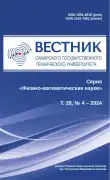Стохастические сверхупругие свойства материалов с фазовыми превращениями
- Авторы: Сараев Л.А.1
-
Учреждения:
- Самарский национальный исследовательский университет имени академика С.П. Королева
- Выпуск: Том 28, № 4 (2024)
- Страницы: 721-739
- Раздел: Механика деформируемого твердого тела
- URL: https://journal-vniispk.ru/1991-8615/article/view/311037
- DOI: https://doi.org/10.14498/vsgtu2129
- EDN: https://elibrary.ru/NOXAGA
- ID: 311037
Цитировать
Полный текст
Аннотация
Проведено исследование влияния стохастических изотермических фазовых превращений в нестабильном материале на его сверхупругое упрочнение.
Получено стохастическое дифференциальное уравнение, описывающее динамику образования и роста объема новой фазы, а также ее взаимодействие с исходной фазой в зависимости от уровня необратимых структурных деформаций.
Установлены макроскопические определяющие соотношения для нестабильного материала, учитывающие стохастическую природу фазовых превращений и зависимость от структурных деформаций. На основе этих соотношений вычислены эффективные модули упругости материала.
Сформулированы стохастические дифференциальные уравнения для прямых и обратных фазовых переходов.
Результаты численного моделирования демонстрируют высокую согласованность с экспериментальными данными, подтверждая адекватность предложенной модели.
Полный текст
Открыть статью на сайте журналаОб авторах
Леонид Александрович Сараев
Самарский национальный исследовательский университет имени академика С.П. Королева
Автор, ответственный за переписку.
Email: saraev_leo@mail.ru
ORCID iD: 0000-0003-3625-5921
SPIN-код: 5418-0800
Scopus Author ID: 6603157677
ResearcherId: B-4696-2019
http://www.mathnet.ru/person39033
доктор физико-математических наук, профессор; профессор; кафедра математики и бизнес-информатики
Россия, 443086, Самара, ул. Московское ш., 34Список литературы
- Исупова И. Л., Трусов П. В. Математическое моделирование фазовых превращений в сталях при термомеханической нагрузке // Вестник ПНИПУ. Механика, 2013. №3. С. 126–156. EDN: RDKNHT.
- Мишустин И. В., Мовчан А. А. Моделирование фазовых и структурных превращений в сплавах с памятью формы, происходящих под действием немонотонно меняющихся напряжений // Изв. РАН. МТТ, 2014. №1. С. 37–53. EDN: SAKMWR.
- Мишустин И. В., Мовчан А. А. Аналог теории пластического течения для описания деформации мартенситной неупругости в сплавах с памятью формы // Изв. РАН. МТТ, 2015. №2. С. 78–95. EDN: TPPBQN.
- Казарина С. А., Мовчан А. А., Сильченко А. Л. Экспериментальное исследование взаимодействия фазовых и структурных деформаций в сплавах с памятью формы // Механика композиционных материалов и конструкций, 2016. Т. 22, №1. С. 85–98. EDN: VWWEBJ.
- Мовчан А. А., Сильченко А. Л., Казарина С. А. Экспериментальное исследование и теоретическое моделирование эффекта перекрестного упрочнения сплавов с памятью формы // Деформация и разрушение материалов, 2017. №3. С. 20–27. EDN: YFYNPD.
- Трусов П. В., Волегов П. С., Исупова И. Л. [и др.] Многоуровневая модель для описания твердотельных фазовых превращений в многокомпонентных сплавах // Вестник Пермского научного центра УрО РАН, 2016. №4. С. 82–90. EDN: XHOMKN.
- Тихомирова К. А. Изотермическое деформирование сплава с памятью формы в разных температурных интервалах. Случай одноосного растяжения // Механика композиционных материалов и конструкций, 2017. Т. 23, №2. С. 263–282. EDN: ZFCCHD.
- Тихомирова К. А. Феноменологическое моделирование фазовых и структурных деформаций в сплавах с памятью формы. Одномерный случай // Вычислительная механика сплошных сред, 2018. Т. 11, №1. С. 36–50. EDN: UODJWG. DOI: https://doi.org/10.7242/1999-6691/2018.11.1.4.
- Тихомирова К. А. Экспериментальное и теоретическое исследование взаимосвязи фазовой и структурной деформаций в сплавах с памятью формы // Вестник ПНИПУ. Механика, 2018. №1. С. 40–57. EDN: YUPEYL. DOI: https://doi.org/10.15593/perm.mech/2018.1.04.
- Mutter D., Nielaba P. Simulation of the shape memory effect in a NiTi nano model system // J. Alloys Comp., 2013. vol. 577 (Suppl. 1). pp. S83–S87. DOI: https://doi.org/10.1016/j.jallcom.2012.01.095.
- Auricchio F., Bonetti E., Scalet G., Ubertini F. Theoretical and numerical modeling of shape memory alloys accounting for multiple phase transformations and martensite reorientation // Int. J. Plasticity, 2014. vol. 59. pp. 30–54. DOI: https://doi.org/10.1016/j.ijplas.2014.03.008.
- Yu C., Kang G., Kan Q. Crystal plasticity based constitutive model of NiTi shape memory alloy considering different mechanisms of inelastic deformation // Int. J. Plasticity, 2014. vol. 54. pp. 132–162. DOI: https://doi.org/10.1016/j.ijplas.2013.08.012.
- Elibol C., Wagner M. F.-X. Investigation of the stress-induced martensitic transformation in pseudoelastic NiTi under uniaxial tension, compression and compression–shear // Mater. Sci. Eng. A, 2015. vol. 621. pp. 76–81. DOI: https://doi.org/10.1016/j.msea.2014.10.054.
- Lobo P. S., Almeida J., Guerreiro L. Shape memory alloys behaviour: A review // Procedia Eng., 2015. vol. 114. pp. 776–783. DOI: https://doi.org/10.1016/j.proeng.2015.08.025.
- Yoo Y.-I., Kim Y.-J., Shin D.-K., Lee J.-J. Development of martensite transformation kinetics of NiTi shape memory alloys under compression // Int. J. Solids Struct., 2015. vol. 64–65. pp. 51–61. DOI: https://doi.org/10.1016/j.ijsolstr.2015.03.013.
- Cisse C., Zaki W., Ben Zineb T. A review of constitutive models and modeling techniques for shape memory alloys // Int. J. Plasticity, 2016. vol. 76. pp. 244–284. DOI: https://doi.org/10.1016/j.ijplas.2015.08.006.
- Fabrizio M., Pecoraro M., Tibullo V. A shape memory alloy model by a second order phase transition // Mech. Research Commun., 2016. vol. 74. pp. 20–26. DOI: https://doi.org/10.1016/j.mechrescom.2016.03.005.
- Ильина Е. А., Сараев Л. А. Моделирование фазовых превращений и сверхупругого упрочнения нестабильных материалов // Вестн. Сам. гос. техн. ун-та. Сер. Физ.-мат. науки, 2018. Т. 22, №3. С. 407–429. EDN: YOYJOH. DOI: https://doi.org/10.14498/vsgtu1626.
- Ильина Е. А., Сараев Л. А. Влияние кинетики фазовых превращений на сверхупругое упрочнение нестабильного материала // Современные материалы, техника и технологии, 2017. №7. С. 28–38. EDN: YLTBDG.
- Сараев Л. А. Математическое моделирование упругопластических свойств многокомпонентных композиционных материалов. Самара: Самарский научный центр, 2017. 222 с. EDN: SHDNIT.
- Сараев Л. А. К теории упругости микронеоднородных сред, учитывающей стохастические изменения связности составляющих компонентов // Вестник ПНИПУ. Механика, 2021. №2. С. 132–143. EDN: OYVQLK. DOI: https://doi.org/10.15593/perm.mech/2021.2.12.
- Cahn R. W., Haasen P. Physical Metallurgy. Amsterdam: North-Holland Physics Publ., 1983. xxxiv+1957 pp.
- Кузнецов Д. Ф. Стохастические дифференциальные уравнения: теория и практика численного решения. СПб.: Политехнич. ун-т, 2007. 777 с. EDN: QJRVXX. DOI: https://doi.org/10.18720/SPBPU/2/s17-228.
- Беляев С. П., Волков А. Е., Ермолаев В. А. [и др.] Материалы с эффектом памяти формы. Т. 3. СПб.: НИИХ СПбГУ, 1998. 474 с.
Дополнительные файлы










